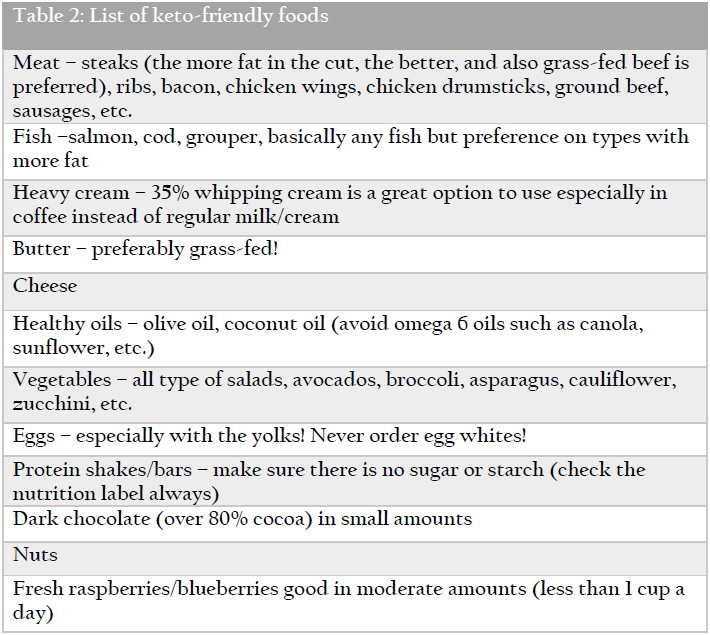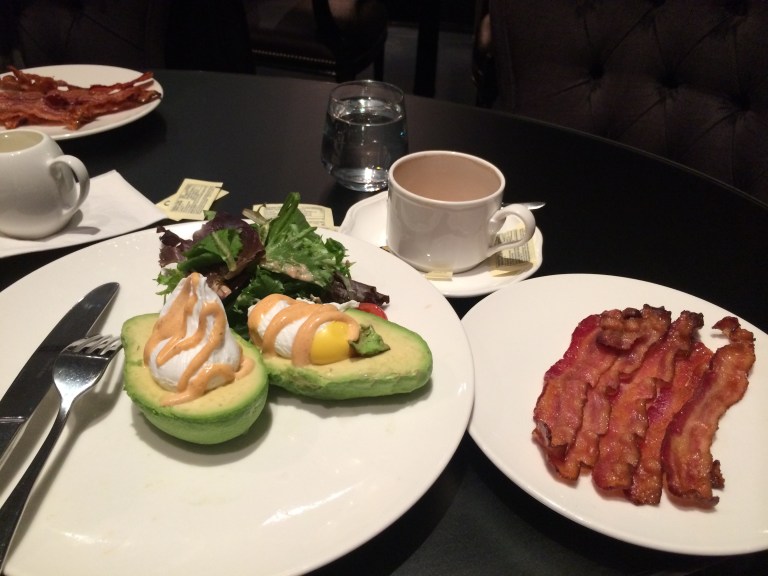I have always wondered if there was a way to become lean and healthy, without sacrificing tasty foods, in a long term sustainable way. I’m happy to announce that I’ve found it! It is called the Ketogenic Diet and the best part about it is, once you know all the facts, it doesn’t take much effort and it becomes second nature to the way you look at food.
About a year and a half ago, I decided to become the healthiest I’ve ever been. At first, I believed what most people still think is the right path to follow: Eat less fat and do more cardio (the more hours on the treadmill, the better, I thought). It took some time for me to learn that eating lots of carbs (even “healthy whole grains”) was not the best way to get healthy and lean, and that spending hours doing cardio was actually the least efficient workout you can do at the gym. Now that I know much better, I can share my new knowledge with you!
How Carbs Make People Fat
To start off… we will look into what carbs are and how they affect our bodies.
A “normal” person that does not restrict carbs, on average, takes in over 275 grams of carbs a day (reference here). As carbs are quickly broken down and enter the bloodstream, they increase the amount of sugar (glucose) in the bloodstream. The level of sugar in the bloodstream is called your blood sugar level. As you eat carbs, your blood sugar level rises rapidly, which activates the hormone insulin to suck the excess sugar out of the bloodstream and into your muscles (which can absorb about 300-400 grams) and your liver (which can absorb about 100 grams).
What happens if your sugar storage tanks (muscle & liver) are full and you keep on eating carbs? Any excess glucose that is not used by the body for energy will be stored as fat!
For example, even when you eat bread (yes, even the “healthy whole wheat” type), it already starts turning into sugar when it’s in your mouth, before it even hits your stomach. As you chew, saliva surrounds the starch molecules of the bread and breaks them apart. Starches convert into maltose, a type of sugar, right on your tongue. Once maltose reaches your intestine, enzymes convert it to glucose (which then, just like every other carb, goes into your bloodstream and spikes your insulin). It’s hard to believe that something that is not sweet, such as this example of bread, turns into sugar in our bodies. Most people don’t even realize this and think the only unhealthy carb is sugar, however bread and pasta have the exact same effect, if not worse.
Examples of Carbs
Just so everyone has the proper understanding of what kind of foods are carbs:

Ketogenic Diet – what is it?
I currently follow what is known as a “ketogenic” diet – a diet that puts your body into “nutritional ketosis”. To simplify, it is a low-carbohydrate diet that restricts carbs to under 50 grams a day. Even though carbs are very minimal, you maintain the recommended amount of calories you take in per day (you do not restrict calories). Once you take in less than 50 grams of carbs a day, your body starts producing something called “ketones” (hence where the ketosis/ketogenic terms come from).
Once you are in ketosis, your body gets its energy from the ketones you produce instead of the carbs that you are no longer eating. Ketones are actually created from your own bodyfat! Doesn’t everyone want their energy source to be from their own bodyfat instead of feeling like a slave to the next carb intake? And after the two week adaptation phase, you no longer crave any carbs and you feel full longer!
During a ketogenic diet, aside from the adequate protein you need (1g of protein per lean body mass per day), you replace the carbs in your meals with dietary fat. This includes saturated fat (future post coming on why saturated fat is good for you). All of a sudden, steak, ribs, bacon, cream, butter, cheese and all that good stuff is what you need to be eating! Adding that extra fat to your diet will actually make you lose bodyfat! I think this was the most difficult fact to understand – that eating fat does not actually turn into fat when you eat it (in fact, carbs are more likely to do that).
It is almost hard to believe this is all true. A ketogenic diet lowers your body fat mass (reference here) and increases your HDL level (reference here). It also provides therapeutic benefits for several diseases such as cancer and epilepsy (reference here). I’ve discussed this diet with health practitioners including cardiologists, who support these conclusions and even follow it themselves.

Keto-friendly foods
The following foods can be incorporated to your everyday meals while on the ketogenic diet:


Myths
Some misunderstandings about the low-carb high-fat diets include:
- “Your brain needs carbs to survive“: Your brain can use glucose (carbs) OR it can use ketones. Once you become keto-adapted, your brain uses the ketones (more efficiently than it uses glucose) produced by your body for energy. (reference here)
- “You will crave carbs all the time and be miserable“: Once you become keto-adapted, your brain no longer wants carbs as an energy source therefore cravings drop. Also, the insulin spikes with plummeting blood sugar levels are no longer experienced, therefore craving of carbs stops because of this too.
- “Your food choices will be so limited it will be impossible to keep up“: So many good foods are low-carb. Since when is eating bacon, steaks, ribs, cheese, cream, butter, considered a sacrifice? I’ll choose those over potatoes any day.
- “Saturated fats are not good for you“: All the recent large scale studies looking at saturated fat consumption clearly show no effects on heart attacks and death. I will write another post soon focusing on this topic alone!
- “When you go too-low-carb, you go into “ketoacidosis” that is bad for you and can even kill you“: Ketoacidosis is mainly a worry only for diabetics and the level of ketones produced goes beyond a level that you can ever reach during nutritional ketosis (reference here)
The Low Carb Bible
The Art and Science of Low Carbohydrate Living by Jeff Volek PhD and Stephen D. Phinney MD PhD
(Along with their sequel book The Art and Science of Low Carbohydrate Performance, same authors)

If you would like to know which book really got me into this diet and lifestyle, this is it. It goes through all the details of going low-carb, along with any misconceptions and things people might say why you shouldn’t do it. It is very scientific and references many clinical studies which I really like. Also, this book is written primarily for medical practitioners to be able to recommend this kind of diet to their patients. This means some of the explanations and terms can be quite technical and advanced, but I found that I generally understood everything. It also means this book is hard to find in general bookstores and you can’t find it at Chapters/Indigo at this time, unfortunately. I had to buy my copies through Ebay and Amazon.
The sequel (Low Carb Performance) is catered to understanding the low-carb diet for athletes and athletic performance rather than the average person, which is important when you are getting to a more advanced stage in training/bodybuilding/etc and want to know how a low-carb diet is affecting your muscle performance.
What about the gym?
Many have heard of the common saying “Abs are made in the gym, but revealed in the kitchen“. If you don’t have the proper diet to become lean, you will never see the results from the hard-earned work you put in at the gym. Stay tuned for my future post on the most effective workout tips! 🙂






Where are you finding your grassfed butter? I’m in Toronto as well and cant seem to find it anywhere.
Thank you!
-A
Hi! I find my grass-fed butter at Whole Foods in Toronto. As far as I’ve seen they carry only one brand called “Rolling Meadows Dairy” and it comes in salted and unsalted versions. It can be found in the regular refrigerated butter section of the store. Thanks and enjoy!
It sounds scientifically legit, I will have to start looking at how many grams of carbs are in my diet, so many of the things I like are in table 1, haha, I don’t want to even ask about beer, haha
Beer surprisingly still only has about 5-7 grams of carbs per drink, similar to wine. But the type of carb in it is starch (instead of fructose in wine). You can always keep limited amounts of beer in your diet if you cut out all other carbs, technically!
Alina! Long time! Glad to hear you’re doing well :).
I love the ketogenic lifestyle! You should look into the bulletproof diet and primal blueprint if you haven’t already. All super effective and super delicious :).
Great blog my friend 🙂
Hi Alina! Great travel blog, but mostly you’ve inspired me to go ketogenic! When you started did you notice a significant improvement in your mental acuity?
You state here it’s been a year and a half, is that accurate or has it been longer since you published this? Still going strong?
Thanks,
Yes still going strong! I think I noticed an improvement once my body adjusted to the new energy source (getting past the adaptation period) which took less than a week. It’s been about 2.5 years now and feeling great! 🙂
Hi Alina,
Love your blog! I was wondering if you’d ever give a week example or outline of your keto diet, how you track your macros and if you test for ketosis. I’ve read a bit of the keto diet book by Leanne Vogel and I find the grocery list is SO expensive ($300 plus for one week). I’m more frustrated than inspired at this point. I was wondering if you could shed some light for me lol.
Any input would be helpful!
While it is true that higher fat/protein (& low carb) foods (such as meat, fish, green vegetables) are more expensive than primarily carb foods (i.e., rice, potatoes, bread, processed foods), if you buy things in bulk and do meal-prep it should come down to a manageable price. Also need to think about how much you will be saving in health-related costs later down the road!
I have checked your website and i have found
some duplicate content, that’s why you don’t rank high in google, but there is a
tool that can help you to create 100% unique articles, search for: Boorfe’s tips unlimited content
This is an awesome read Alina. You’ve done a great job of simplifying what seems to be a confusing subject. I’m going to try this out. Looks like you’re back on the beach in your natural habitat:) You’re awesome..keep living the dream👍
Alina love your photos
Do you drink alcohol or is that completely out of your diet?
Did you lose weight when switching to keto?